same Wikipedia article in spanish
This is a forest ecosystem that people don’t seem to talk about very much, but it’s home to a huge diversity of animals, and many species are endemic. I just want to share this for those who are interested in learning about the natural world and forests in particular. Below are some excerpts from other articles online.
From this article:
This ecoregion is home to some of the largest dry forest remnants in western South America. These forests consist of species adapted to the extremely arid conditions of the dry season, including species of Ceiba tree, papellio and yellow cordia shrub species, and cacti. Other dominant species in the dry forest zone include hualtaco, guayacán, palo santo, ébano, charán, sapote, pasallo, angolo, almendro. It is considered to host one of the highest abundancies of mesquite.
The Tumbes-Piura Dry Forests ecoregion has a significant level of endemism within its flora community attributed to many species adapting to the arid conditions. The Carob tree species is noted for their ability yo capture and fix nitrogen into the soil with its roots, thereby improving nutrient conditions not only for themselves but also for other vegetation species nearby. Characteristic species of fauna in the ecoregion include southern tamandua, Guayaquil squirrel, common green iguana, and various species of birds such as parrots, parakeets, magpies, and some furnarids.
For decades, this ecoregion has been subjected to selective extraction of largely flora and some fauna. However, the habitats and wildlife have seen recovery relatively recently. This is attributed to the establishment of Cerros de Amotape National Park, and the positive effects of El Niño weather pattern that led to an increased water availability the ecosystem. El Niño is an irregular cyclic weather event stemming from warm Pacific Ocean waters causing changes in global climate, chiefly increased precipitation in this area. This increased rainfall helps thousands of plants germinate in the Tumbes-Piura Dry Forests ecoregion, facilitating the recovery of floral species as well as providing food, among other services, for faunal species.
From this article:
The Tumbes-Piura dry forests ecoregion is nestled along the Pacific coast of northwestern Peru and southwestern Ecuador. This unique and remarkable ecosystem is part of the larger Tumbes-Chocó-Magdalena biodiversity hotspot. This ecoregion, often overshadowed by the more well-known tropical rainforests of the Amazon basin, is a biodiversity hotspot in its own right, harboring an exceptional concentration of endemic species and facing significant conservation challenges.
The Tumbes-Piura dry forests are renowned for their exceptional biodiversity and high levels of endemism. This ecoregion is home to numerous plant and animal species found nowhere else on Earth, making it a critical conservation priority. Notable endemic species include the Tumbes Hummingbird (Phaethornis baroni), the Tumbesian Antshrike (Thamnophilus tenuepunctatus), and the Tumbes Swallow (Tachycineta stolzmanni).
Despite its ecological significance, the Tumbes-Piura dry forests face various threats, including habitat loss and degradation due to agricultural expansion, urban development, and unsustainable resource extraction. Additionally, the region is vulnerable to the impacts of climate change, which can further exacerbate the effects of drought and alter the delicate balance of the ecosystem.
The Tumbes-Piura dry forests are a remarkable and often overlooked biodiversity hotspot, a testament to the incredible natural heritage of the Tumbesian region. As we work to safeguard the future of this unique ecosystem, we must recognize its ecological significance and commit to its protection for the benefit of the countless species that call it home and the generations to come.
While the Peruvian portion of the Tumbes-Piura forest has multiple protected areas (bordered in green in image below), Ecuador’s portion remains unprotected. Over 90% of the unprotected forest has been cut down, and the ecoregion is considered critically endangered. Climate change is leading to more rainfall in the region, which has prevented desertification despite the massive deforestation. Extraction of wood for construction and charcoal production were major causes of deforestation in the past, but now, expansion of cow/goat pasture is probably the biggest threat, as it not only involves deforestation, but the grazing animals also kill seedlings and prevent natural regeneration.

The animals who depend on the Tumbes-Piura dry forests need protection just as much as those in other regions. Supporting reforestation of pastures and degraded lands in the region is one way to help them.


